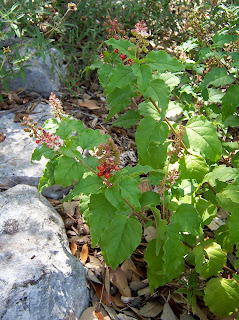We have a horror film showing right out in our garden. Really.
Here’s my young associate to tell you all about it:
 |
This is the wasp that inspired such terror. No really, he's bigger than he appears here. |
Flying drunkenly through the bridal wreath, (Spiraea prunifolia) it cruised through the salvias, (Salvia coccinea) then dropped to the ground like a rock. Feeling like a maiden in distress, I leaped onto the porch, screaming “aaaaaahhgg!!!” in my head over and over again. We had seen this humongous wasp before, but not up close, like this.
The man of the house decided it was a tarantula hawk wasp (Pepsis thisbe/Pepsis formosa). I didn’t care what it was, it had a huge stinger, so keep it away!!!!!!! It turns out this formidable creature was something like a horror movie character. One researcher cited on Wikipedia described the wasps’ sting, “Immediate, excruciating pain that simply shuts down one’s ability to do anything except scream.” Apparently, the intense pain lasts only about 3 minutes, but hey, I’m not one to test theories. Luckily, unless harassed, they usually don’t sting
Here’s how the tarantula hawk wasp got its name:
Imagine this…
It’s a muggy late August evening in Texas. The scent of fermented fruit and rain drifts lazily to you. A fat male black wasp with rust colored wings sits on top of a tall salvia bush. This, you know, is called hill-topping. Suddenly a female wasp drifts lazily through the path of flowers. The male, needing a mate, chooses this fine feminine wasp.
After a few days, this female locates a tarantula. Diving in on the tarantula, the battle begins!! The tarantula wheels up on the wasp, ready to defend itself. The wasp seizes her chance and stings the tarantula under the belly, touching a nerve, and paralyzing it. Unable to fight back, the tarantula is dragged to a hole in the ground, and, rudely, it can be his or her own hole! Talk about unwanted visitors!!
The female wasp then lays a solitary egg in the tarantula and covers the hole. She then leaves the hole to who-knows-where. The larvae hatches, and begins feeding on the almost dead, paralyzed tarantula.
According to Wikipedia, after a few weeks, the larvae pupates. Then, it breaks free!!!!
And if you happen to see a tarantula hawk wasp drifting drunkenly around, remember this: fruit for the wasps is like alcohol for us humans. Too much makes them drunk!
Favorite spot in the garden:
As a said on the last post and will say on the next, the garden looks very grim. One bright spot is the volunteer morning glories. We planted this lovely deep purple variety last year. The new seeds I planted this year did not survive, but the offspring of last year’s plant are doing very well. I am slowly training them to head up the porch posts, but without rain it is slow growing.



